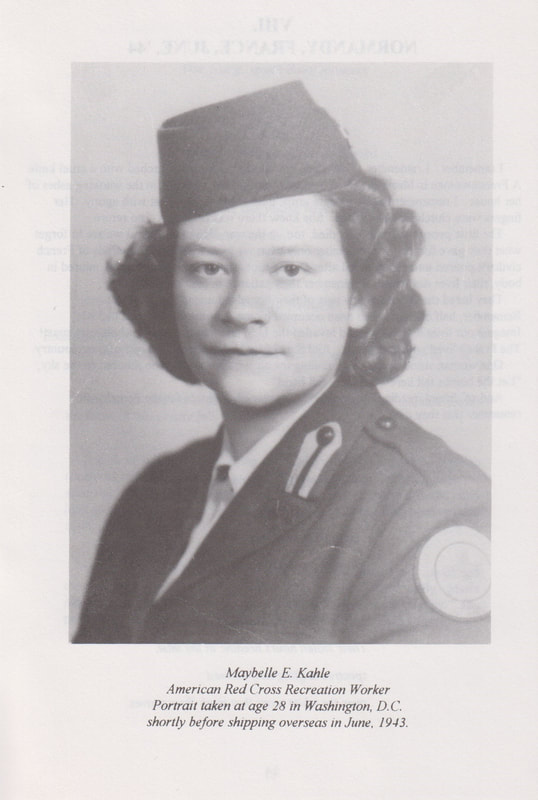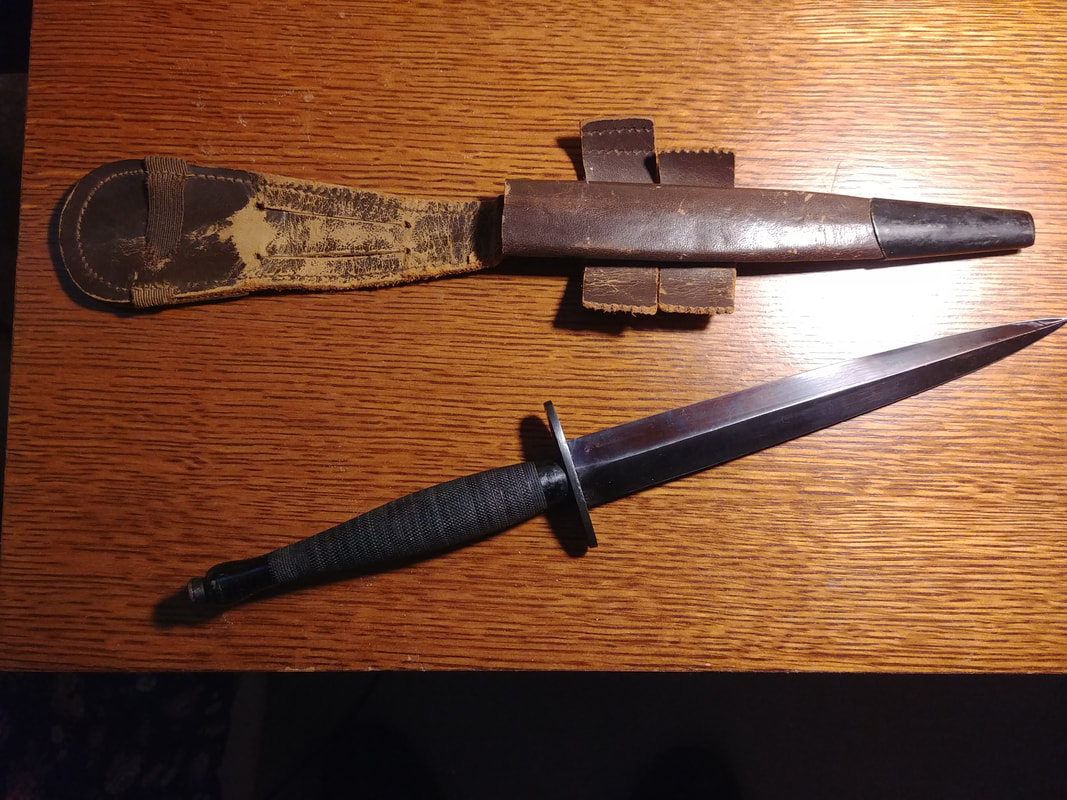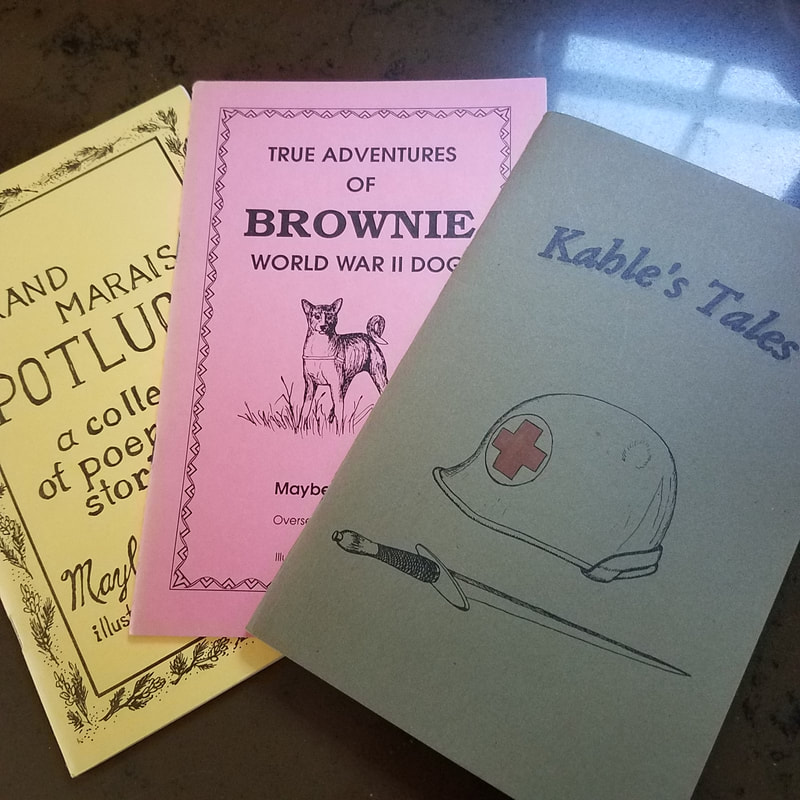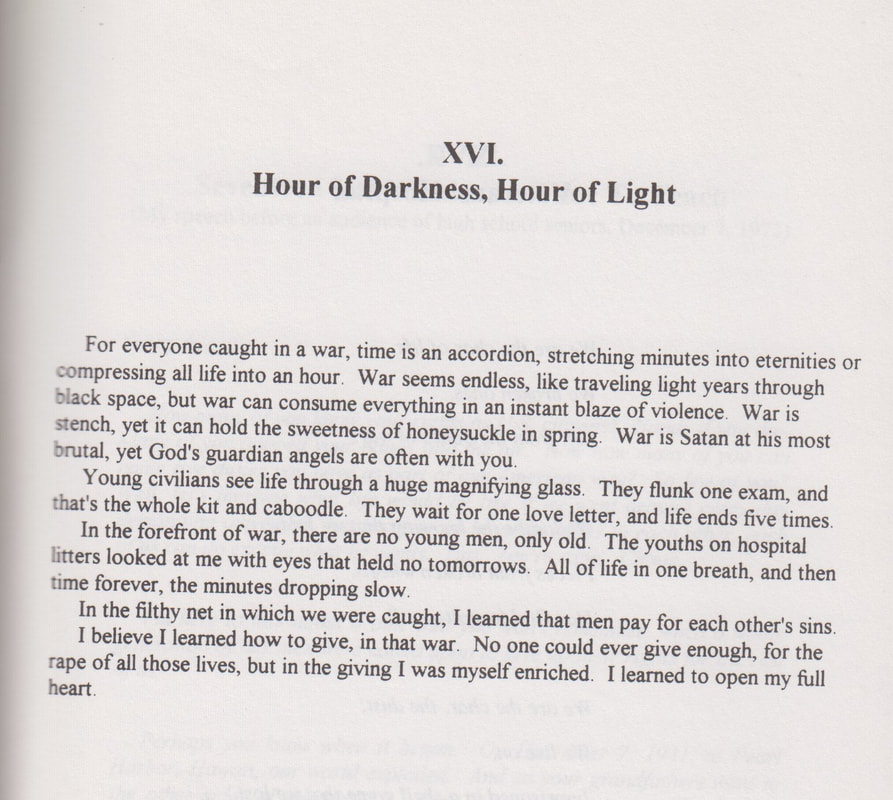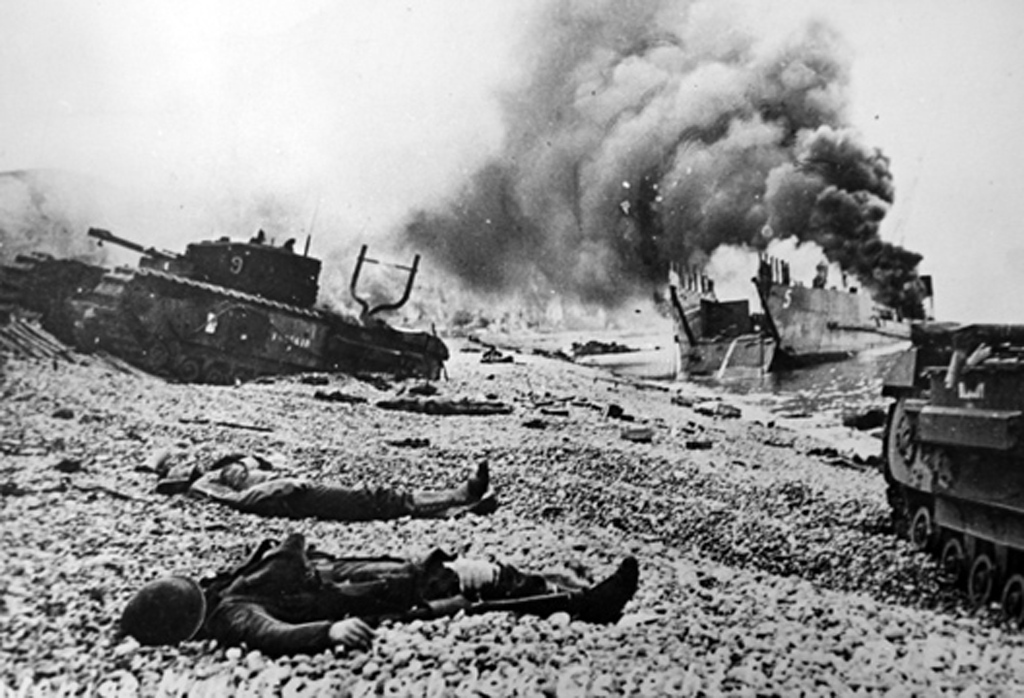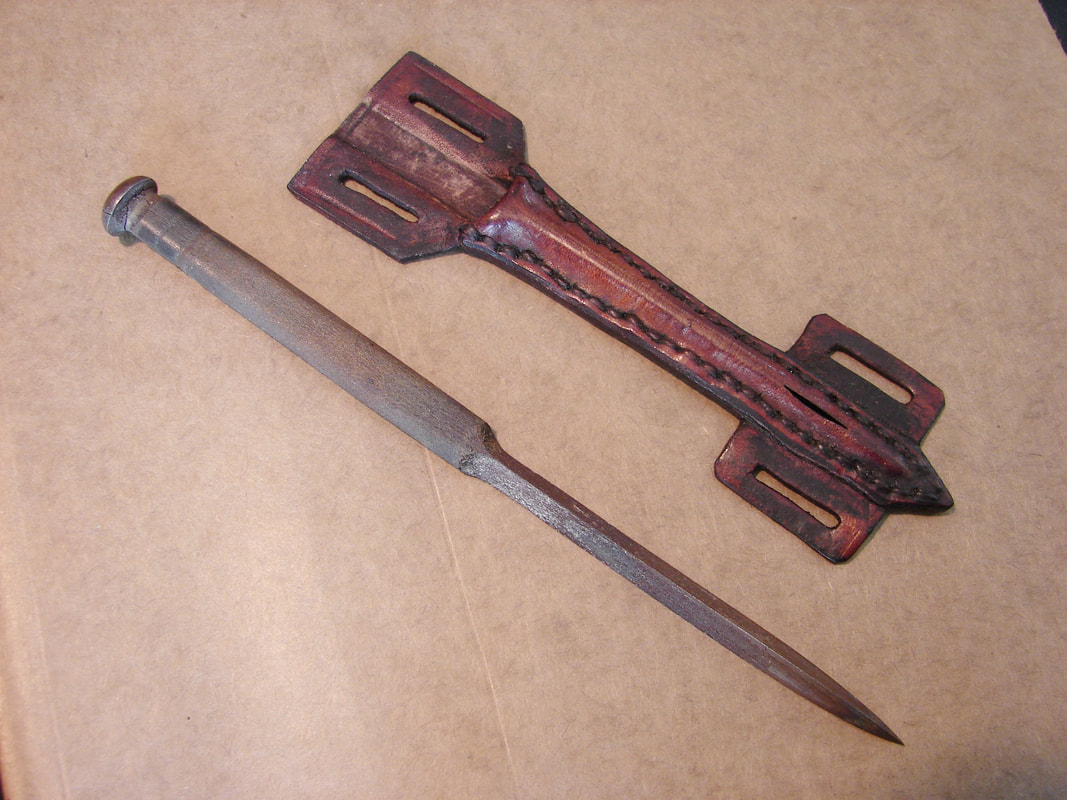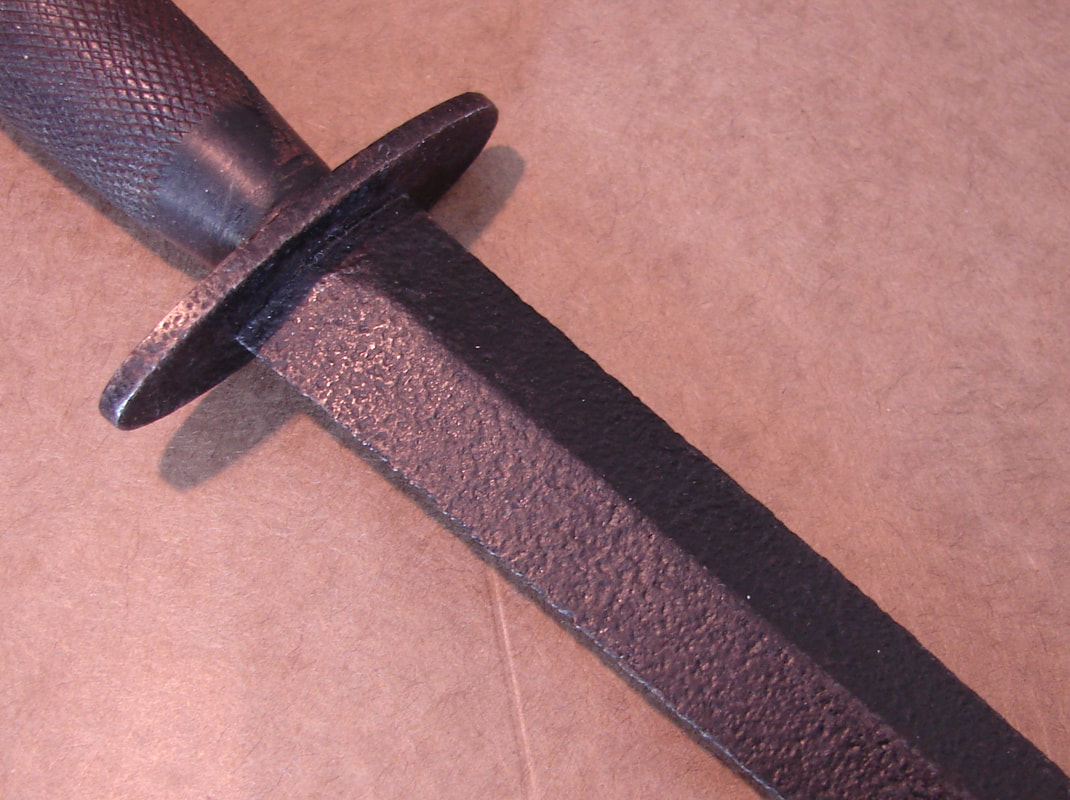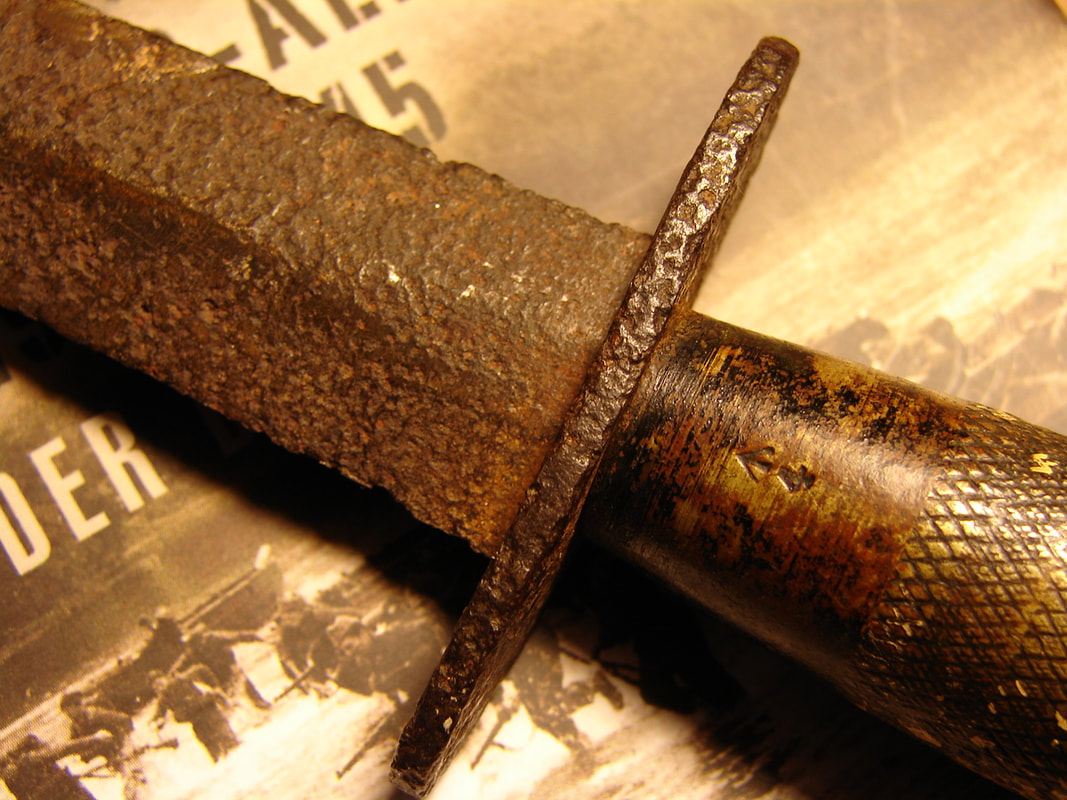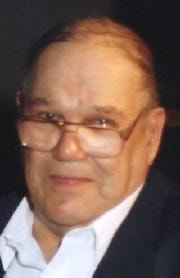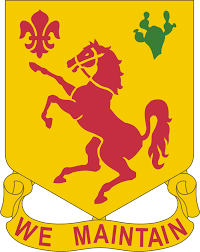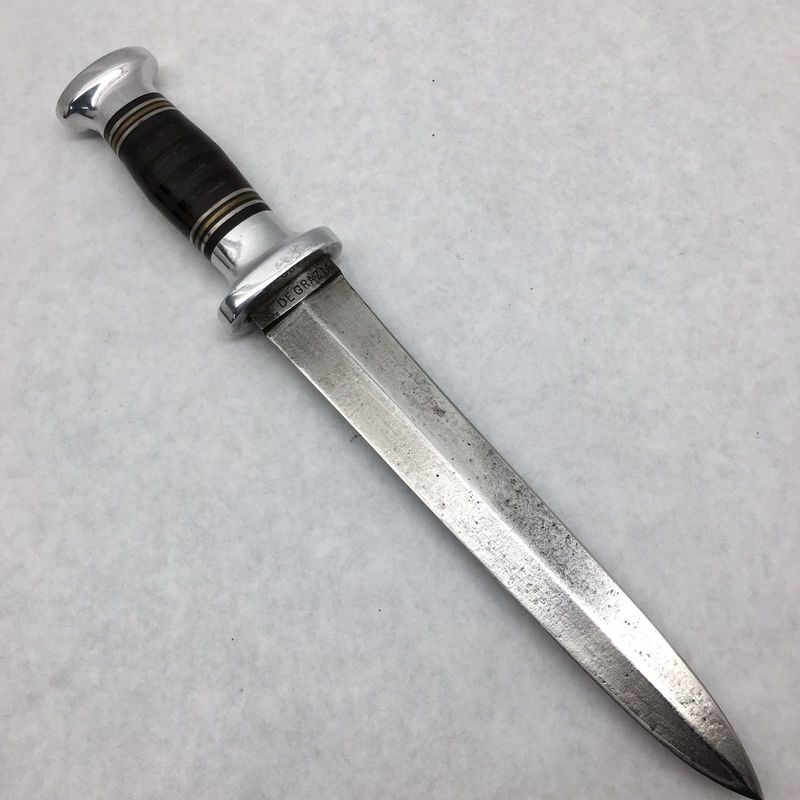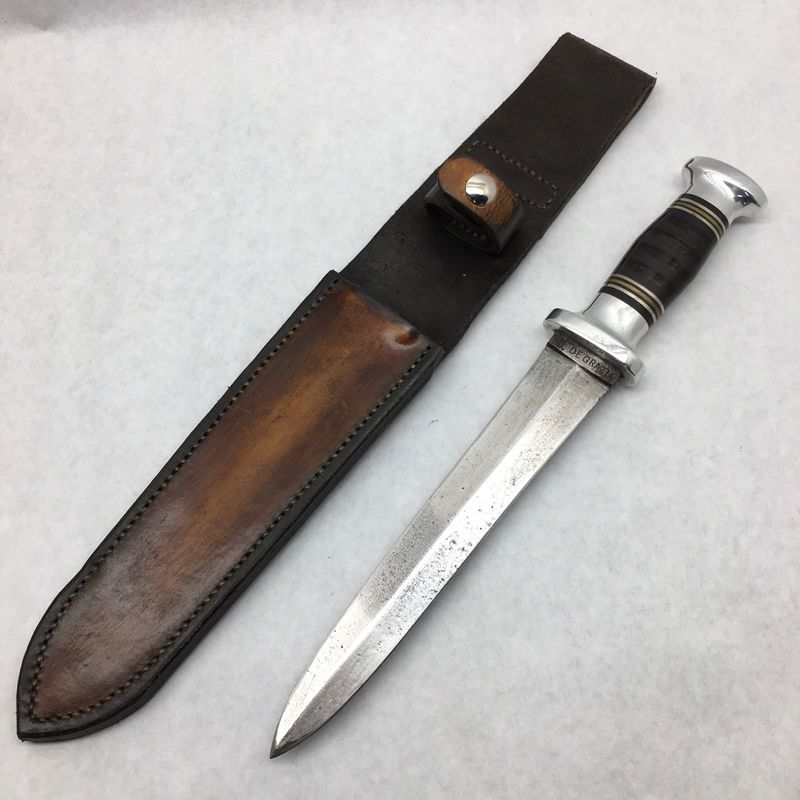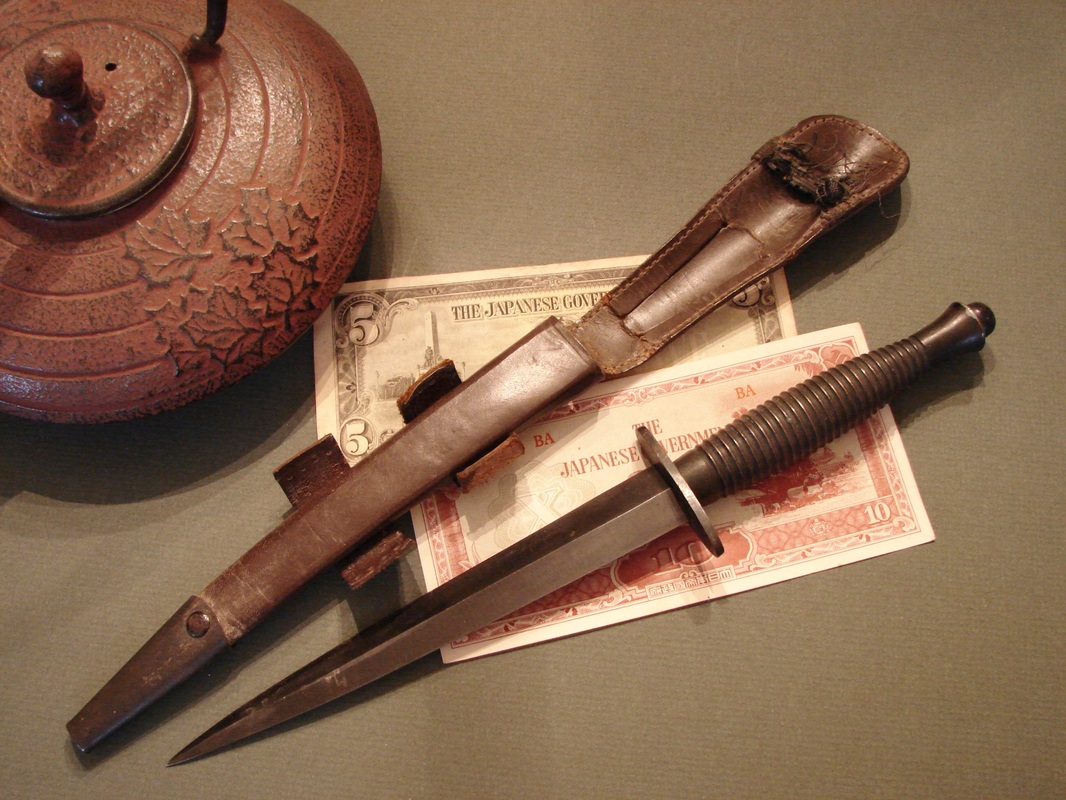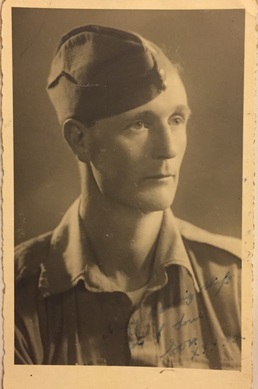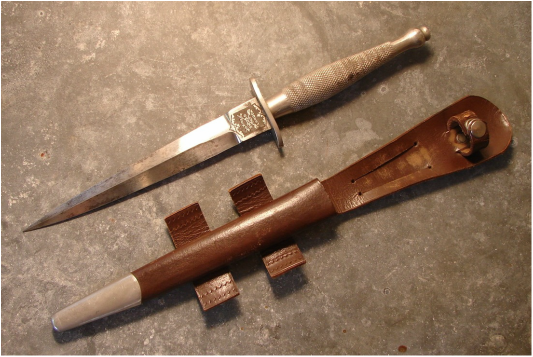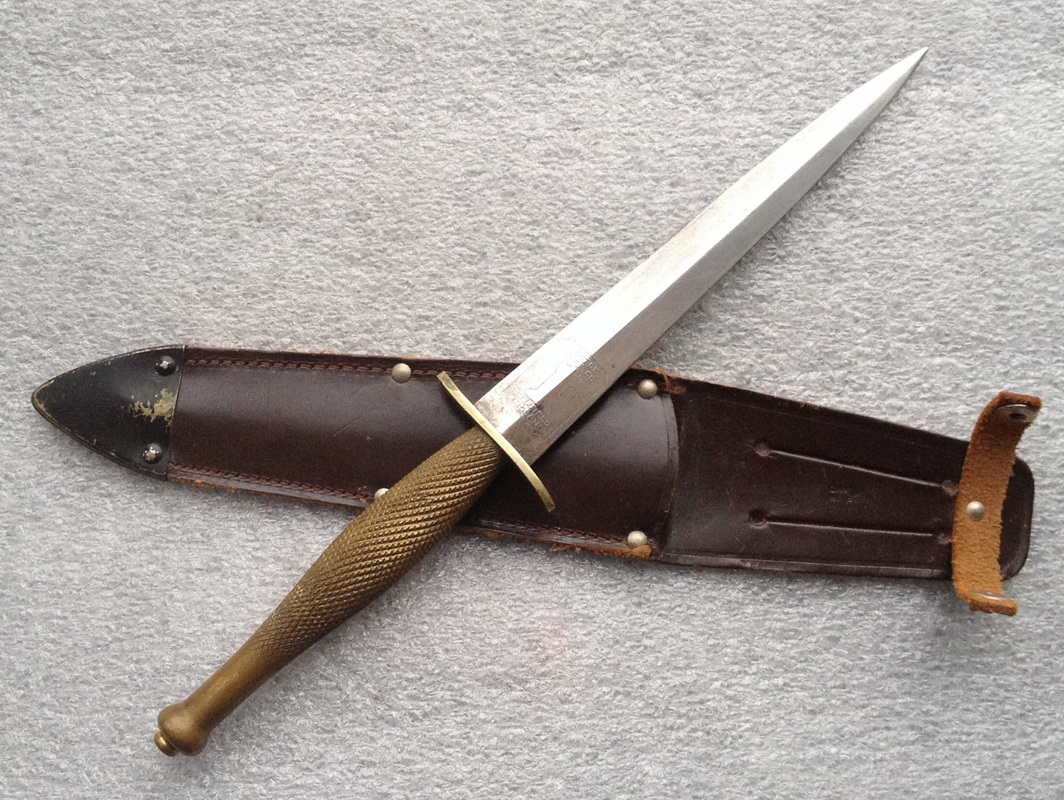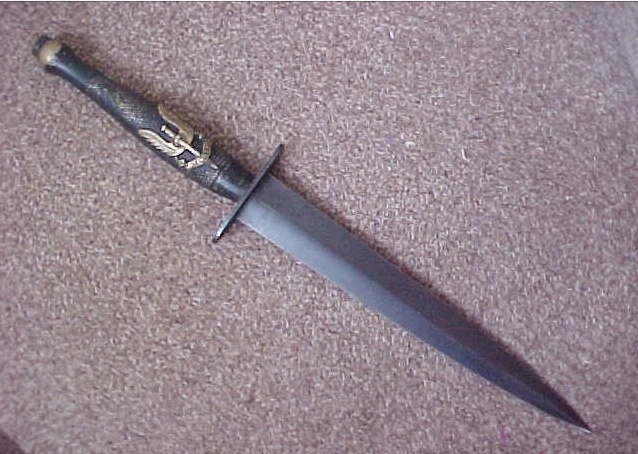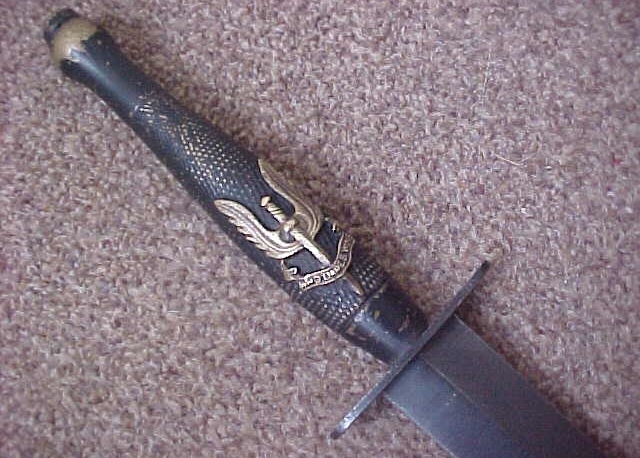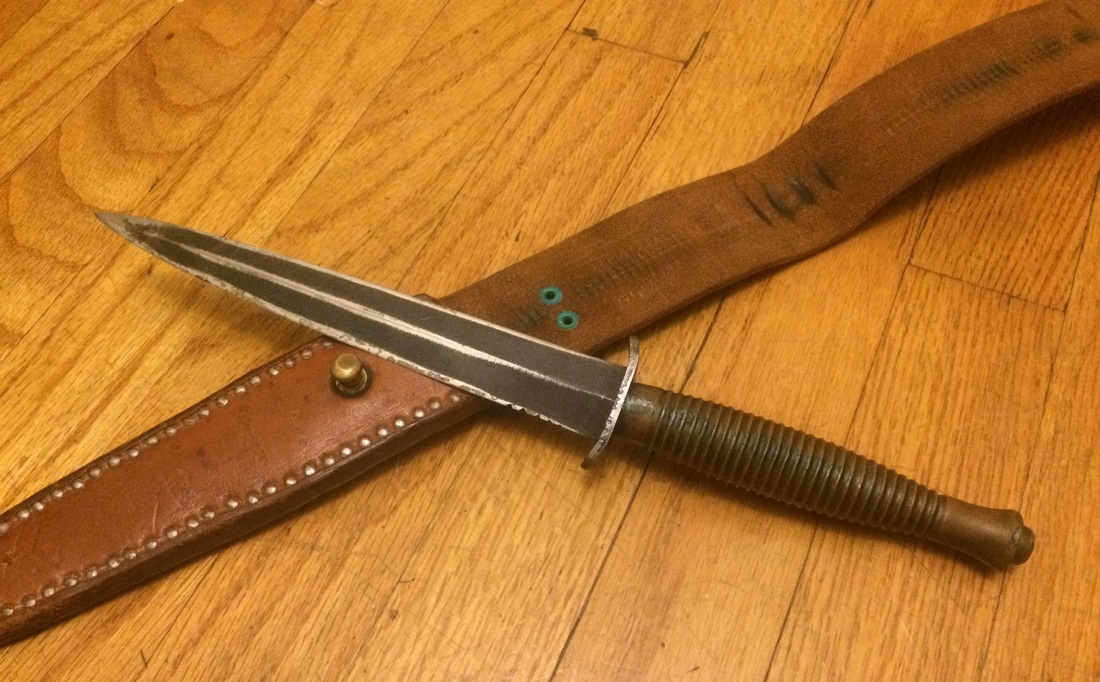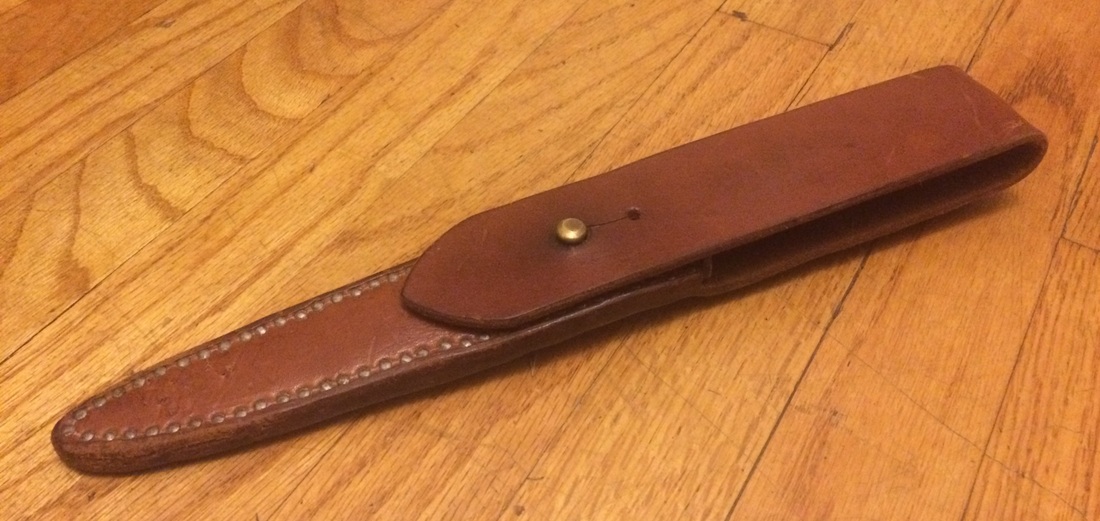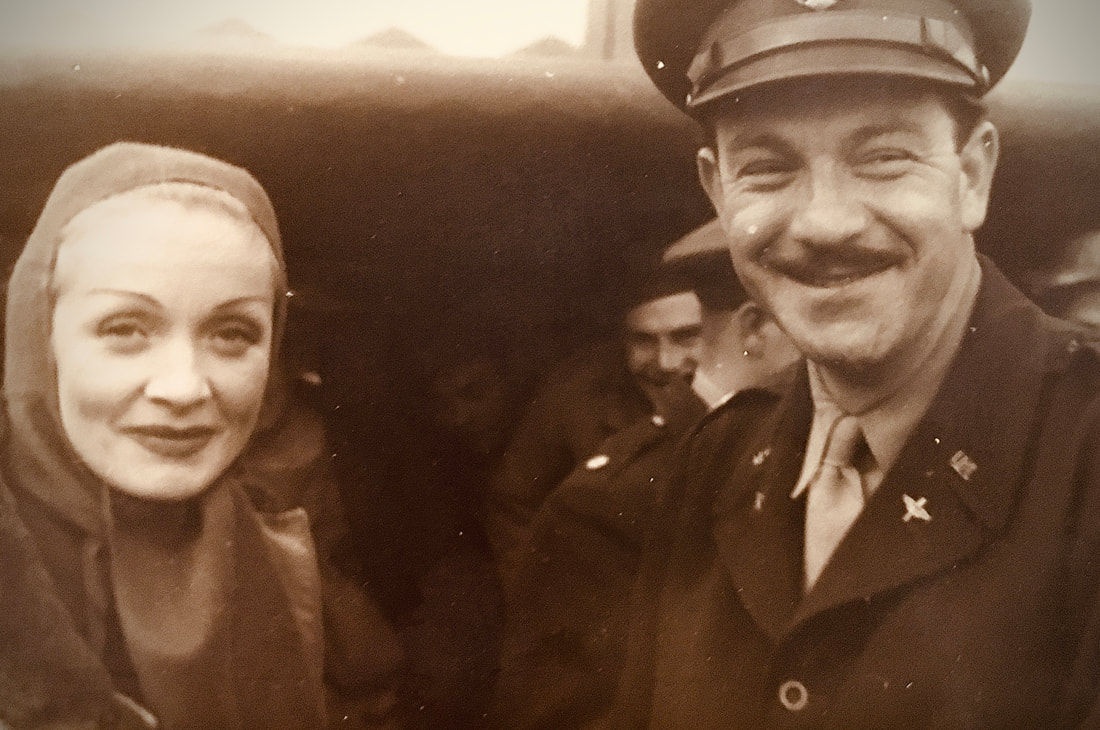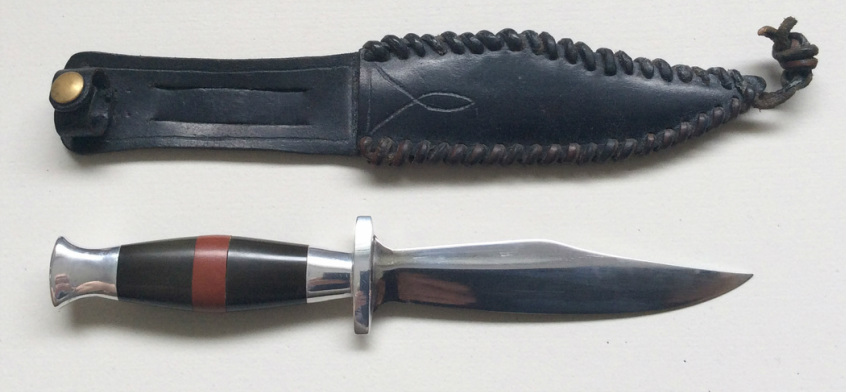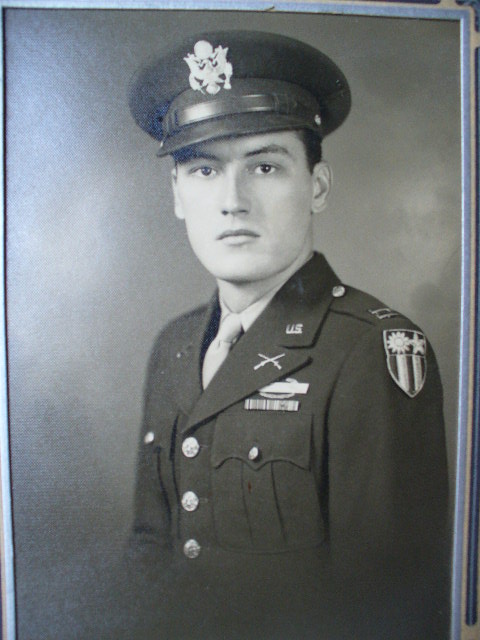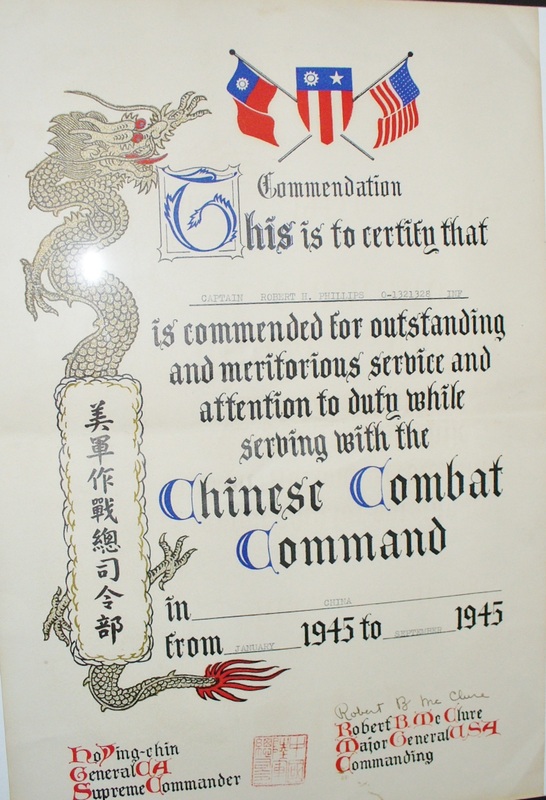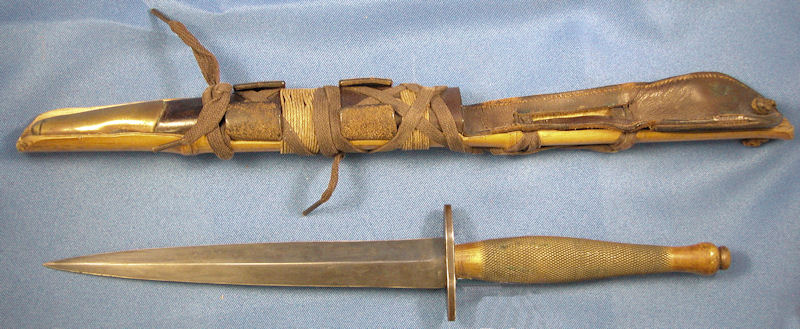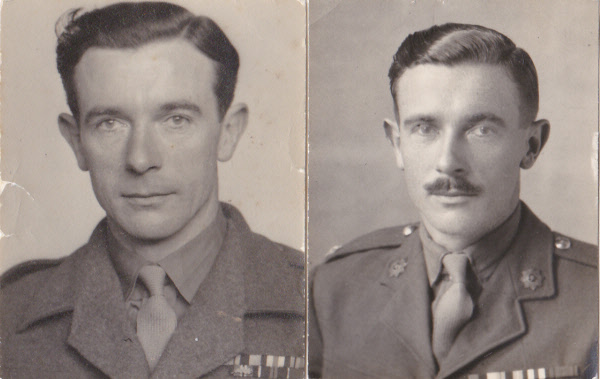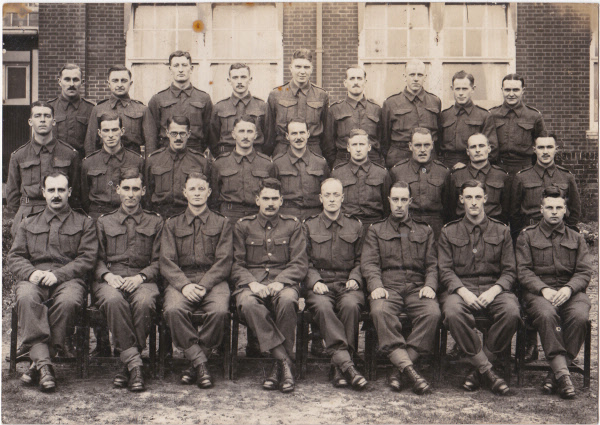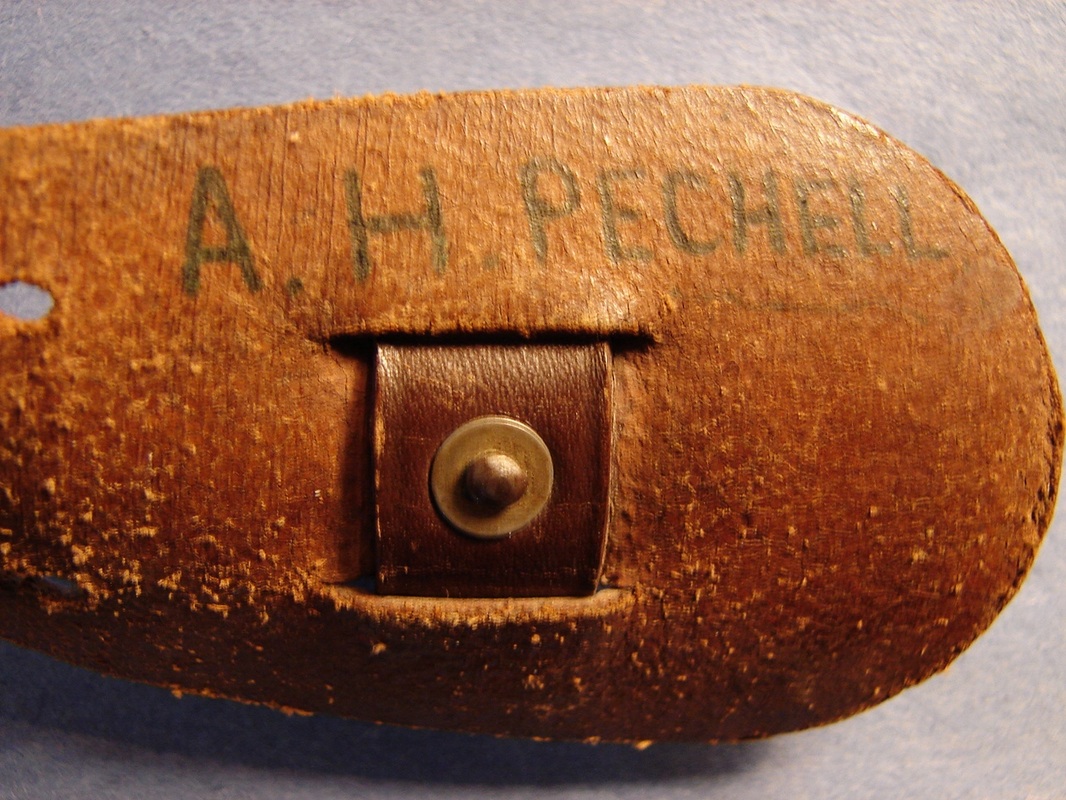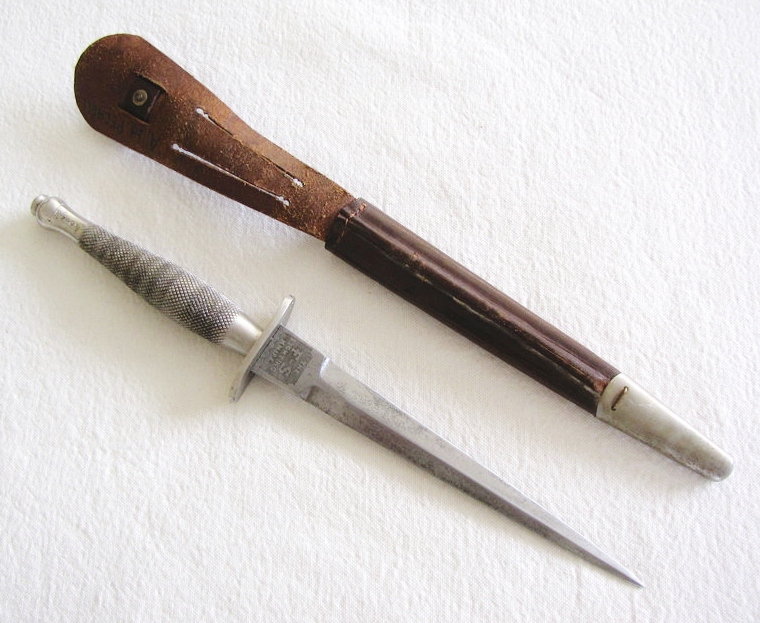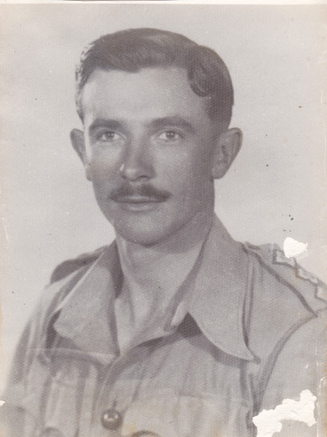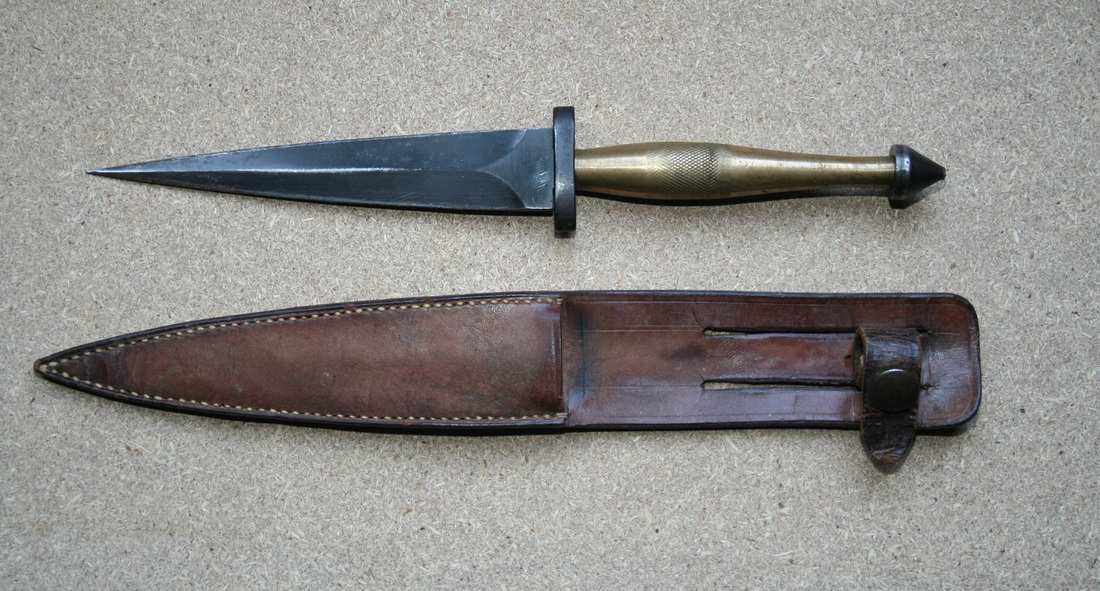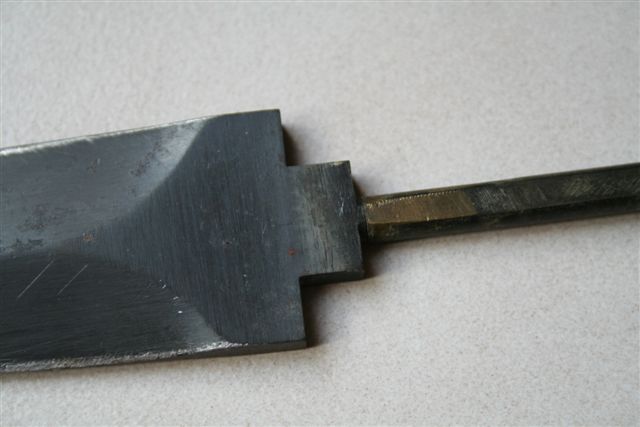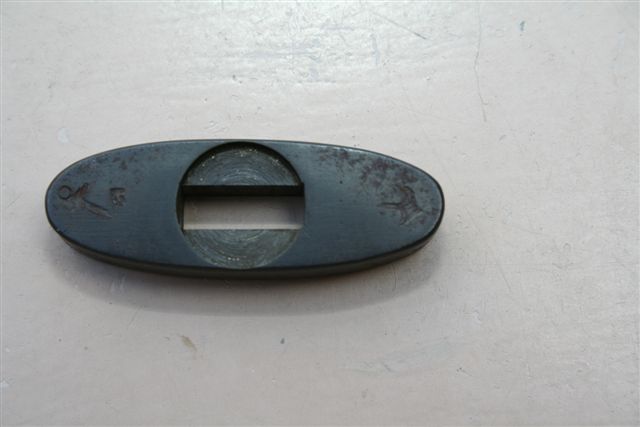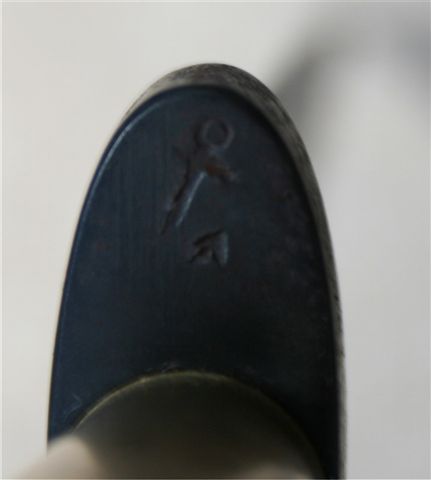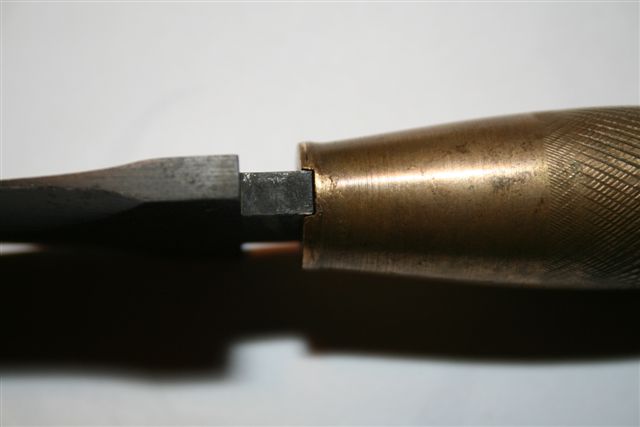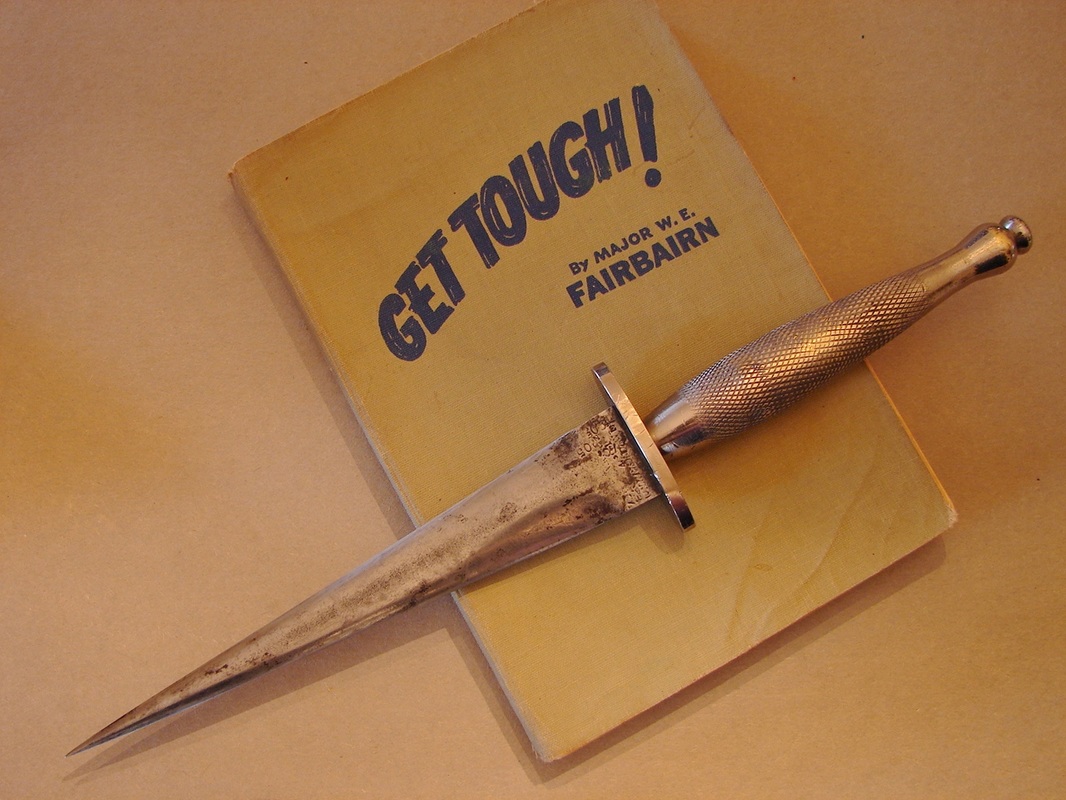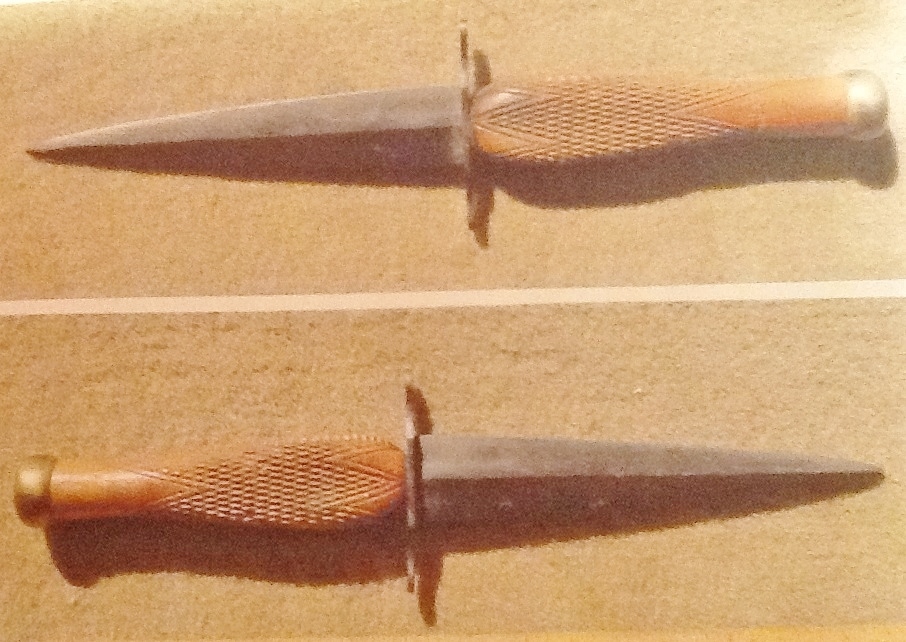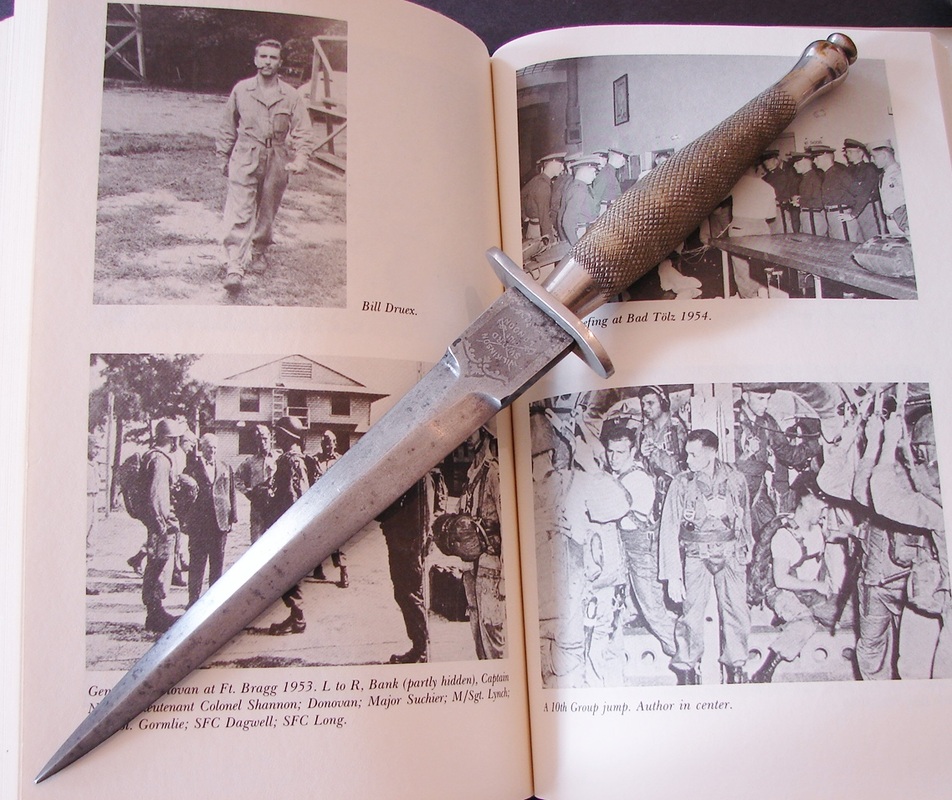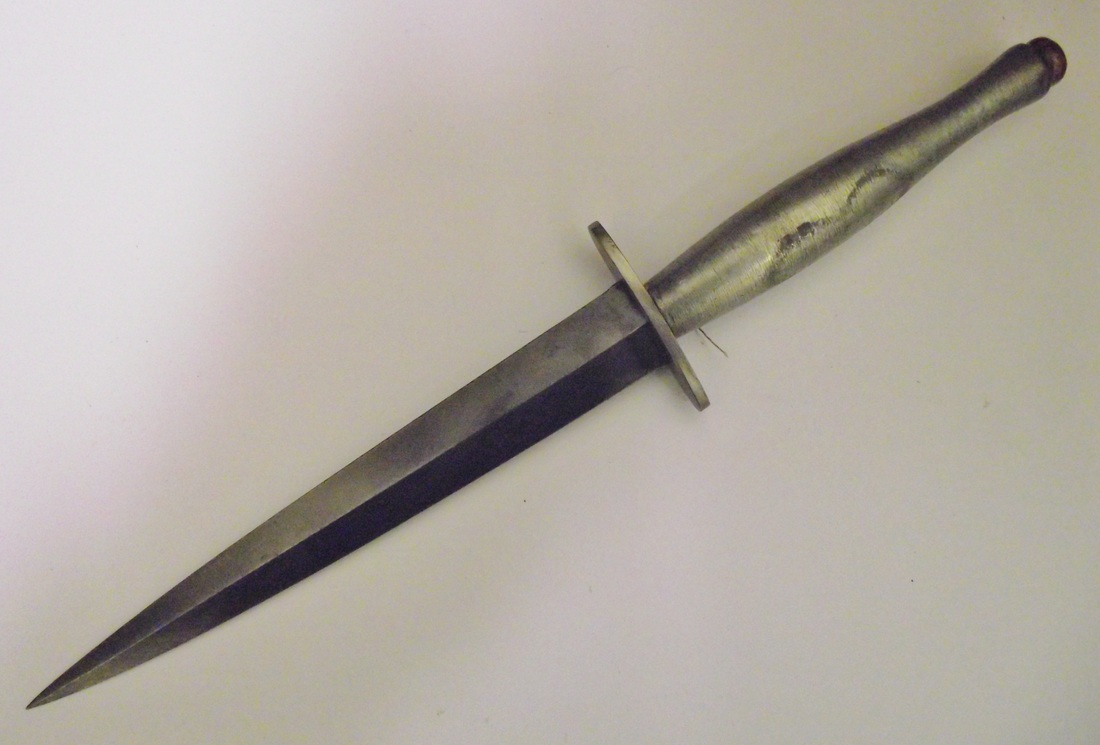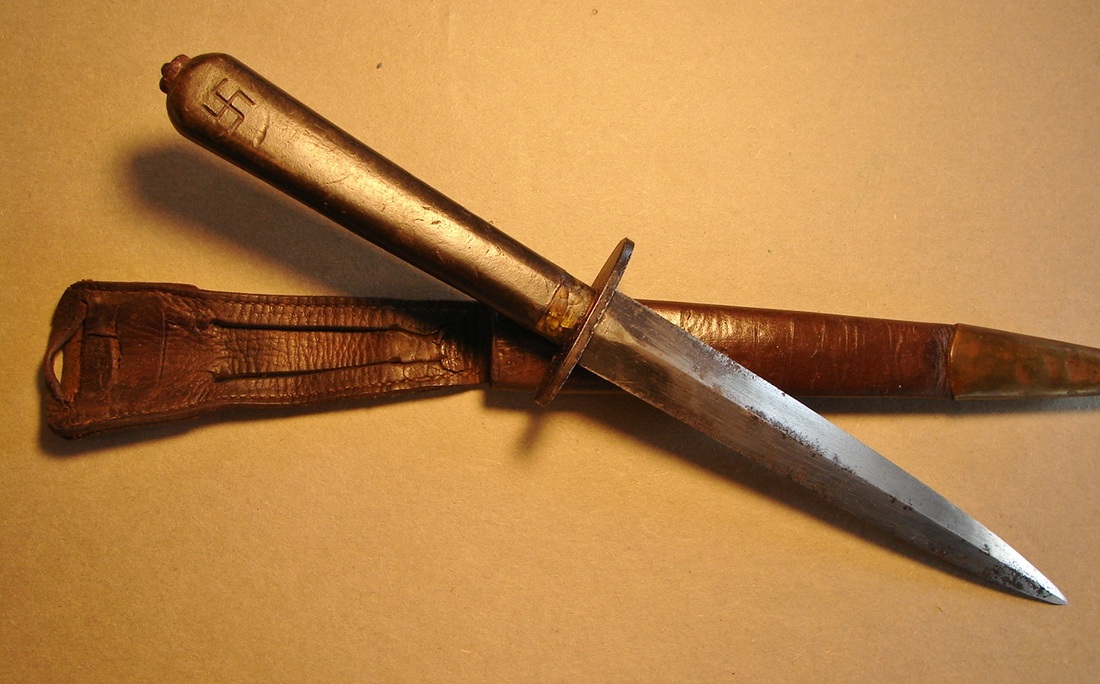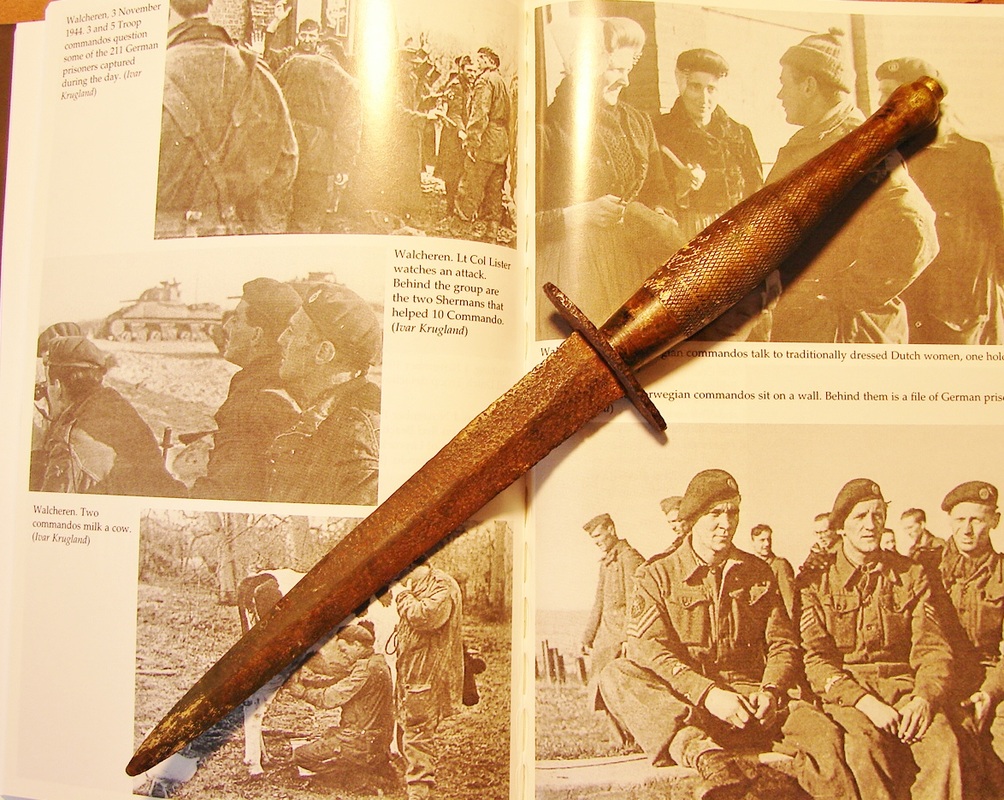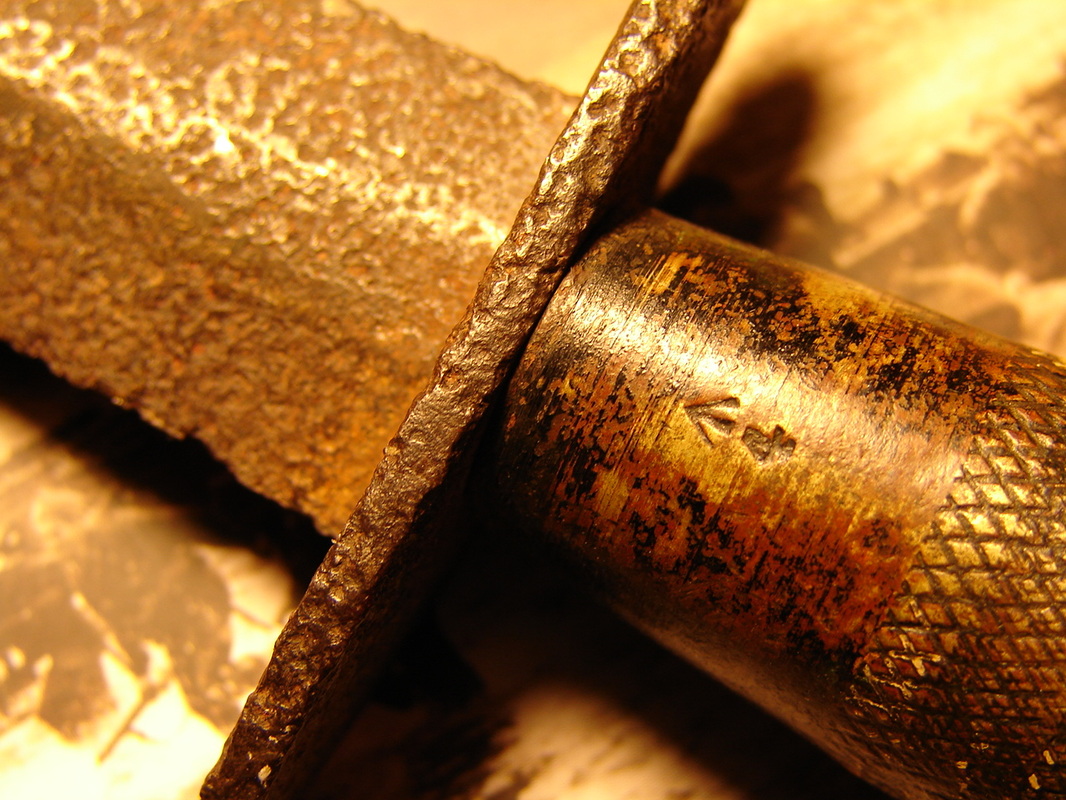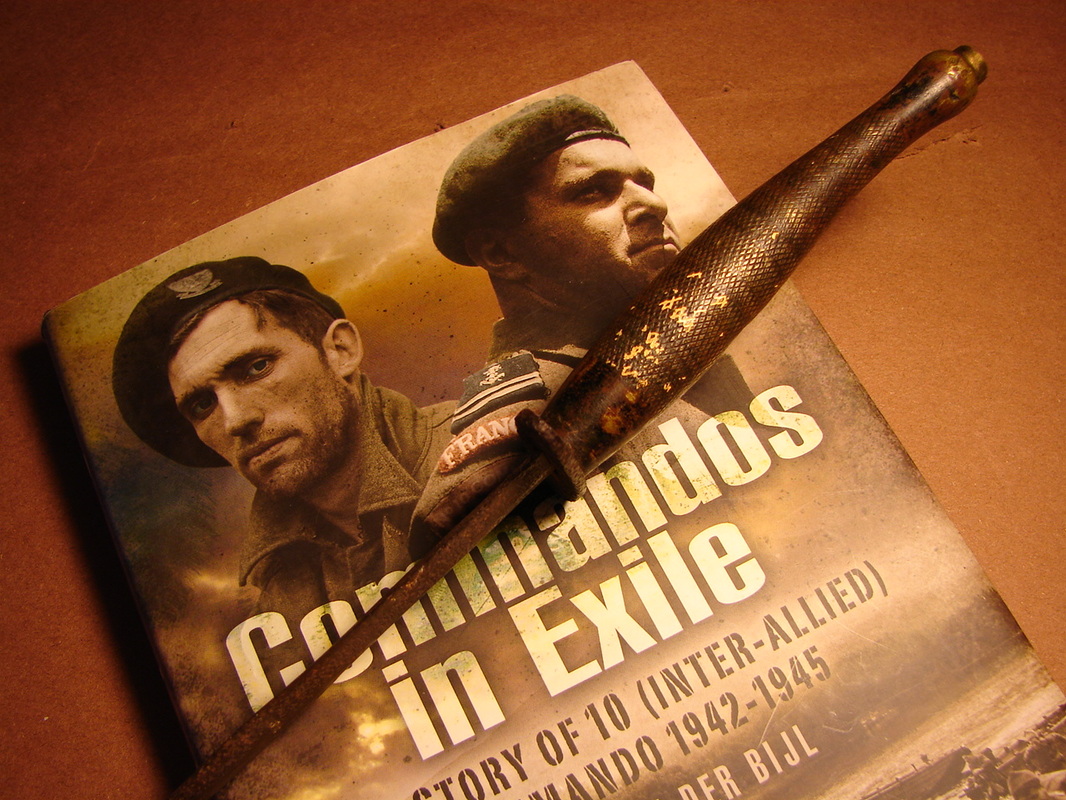The Stories
WW-II and Other Stories: please check back for our continuing growth. Do you have a story about either a commando veteran or knife that you want to share? This invitation is open to collectors and warriors of all ages and wars. Please contact us through the form on the references and links page.
Maybelle Kahle WW-II Red Cross worker
Hi Dave
Appreciate your web site and the info it contains. Based on reading, I am wondering if you could please confirm / ID my F-S knife :
I believe it to be:
An all dark model, 2nd pattern, button hilt with a stamped guard, J. Clarke & Son, Sheffield, 1942, broad arrow stamp. Guard, handle side stamped: broad arrow, 6. Handle has clean edge knurling that is not very deep. The story of this knife is that it never saw action but was given as a gift to an American Red Cross Nurse in the European theater. I could provide details of the story as it was written down by my father as told to him by Maybelle Kahle, the nurse. The knife seems to be in near mint condition.
Best regards
Dan Goewey
Appreciate your web site and the info it contains. Based on reading, I am wondering if you could please confirm / ID my F-S knife :
I believe it to be:
An all dark model, 2nd pattern, button hilt with a stamped guard, J. Clarke & Son, Sheffield, 1942, broad arrow stamp. Guard, handle side stamped: broad arrow, 6. Handle has clean edge knurling that is not very deep. The story of this knife is that it never saw action but was given as a gift to an American Red Cross Nurse in the European theater. I could provide details of the story as it was written down by my father as told to him by Maybelle Kahle, the nurse. The knife seems to be in near mint condition.
Best regards
Dan Goewey
I'm pretty sure Maybelle would not consider herself a heroine. Any young woman who would willingly cast herself into the conflagration of total war is a hero to me. She wrote several small booklets; about normal life before the war, one about a wartime dog named Brownie, and her story of three years on the battle front. Her knife was a present from some British trooper given to provide her with a means of self-defense. I am grateful for Dan's gifts of these endearing stories written by an exceptional lady, Maybelle Kahle 1915 to 1998.
Some Great Wisdom from a woman who had been there and seen all the horror that war could bring. God Bless her.
Raid at Dieppe, France
The assault on the beaches at Dieppe was a disaster of the first magnitude. "The Raid on Dieppe, France, on August 19, 1942, was a pivotal moment in the Second World War. With virtually all of continental Europe under German occupation, the Allied forces faced a well-entrenched enemy. Some method had to be found to create a foothold on the continent, and the Raid on Dieppe offered invaluable lessons for the successful D-Day invasion in 1944, saving countless lives in that momentous offensive.
Canadians made up the great majority of the attackers in the raid. Nearly 5,000 of the 6,100 troops were Canadians. The remaining troops consisted of approximately 1,000 British Commandos and 50 American Rangers. The raid was supported by eight Allied destroyers and 74 Allied air squadrons, eight belonging to the Royal Canadian Air Force (RCAF). Major-General J.H. Roberts, Commander of the 2nd Canadian Division, was Military Force Commander, with Captain J. Hughes-Hallett, Royal Navy (RN) as Naval Force Commander and Air Vice-Marshal T.L. Leigh-Mallory as Air Force Commander. Although extremely valuable lessons were learned in the Raid on Dieppe, a steep price was paid. Of the 4,963 Canadians who embarked for the operation, only 2,210 returned to England, and many of these were wounded. There were 3,367 casualties, including 1,946 prisoners of war; 916 Canadians lost their lives." http://www.veterans.gc.ca/eng/remembrance/history/second-world-war/1942-dieppe-raid
Canadians made up the great majority of the attackers in the raid. Nearly 5,000 of the 6,100 troops were Canadians. The remaining troops consisted of approximately 1,000 British Commandos and 50 American Rangers. The raid was supported by eight Allied destroyers and 74 Allied air squadrons, eight belonging to the Royal Canadian Air Force (RCAF). Major-General J.H. Roberts, Commander of the 2nd Canadian Division, was Military Force Commander, with Captain J. Hughes-Hallett, Royal Navy (RN) as Naval Force Commander and Air Vice-Marshal T.L. Leigh-Mallory as Air Force Commander. Although extremely valuable lessons were learned in the Raid on Dieppe, a steep price was paid. Of the 4,963 Canadians who embarked for the operation, only 2,210 returned to England, and many of these were wounded. There were 3,367 casualties, including 1,946 prisoners of war; 916 Canadians lost their lives." http://www.veterans.gc.ca/eng/remembrance/history/second-world-war/1942-dieppe-raid
Below: Here are some other casualties of the failed assault. These three knives were from different sellers but all were found in the sands of the beaches at Dieppe.
|
Robert E. De Grazia: It took me a while to track down who the R. DeGrazia stamped on the ricasso was, but I finally found this obituary. "He was an Army veteran of World War II having served with the 113th Calvary in France, Belgium, Holland and Germany. He was presented the Chapel of Four Chaplains* Legion of Honor Award, as well as the medal of the Jubilee of Liberty which was awarded by the people of France. He was instrumental in rebuilding the American Legion Post 221 and was a member of the VFW Post 7965 and the DAV Chapter 98 all of Carbondale. He was also a member of the Society of the 28th Division." Belatedly we thank him and his heirs for his service and are honored to have his knife. It is an excellent fighting knife with an 8 1/2 inch blade. The blade is extremely well ground and very sharp. I found this about the Chapel of Four Chaplains on the internet.
"On February 3, 1951 a unique inter-faith chapel was dedicated at Temple University in Philadelphia. The Chapel of the Four Chaplains was dedicated by President Harry S Truman, and Reverend Daniel A. Poling, Clark Poling's father, presided over the activities. Reverend Poling, along with members of the other Chaplains' families were largely responsible for the monumental effort that went into getting the Chapel Completed." "The 113th Cavalry Regiment is a cavalry regiment originating as an Iowa National Guard unit with history tracing back to the 19th century Indian Wars. It was heavily involved in fighting during World War II against German forces in France, Belgium, Holland and Germany from June 1944 - May 1945." Wikipedia |
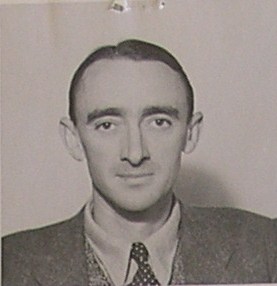
James Alexander E. MacPherson: This is the information that was forwarded on to me by the seller. "What my grandmother told us:
The commando dagger was issued to a cousin of hers while a member of Force 136, a unit operating behind Japanese lines in the Far-East during WW2. Her cousin passed through Ceylon during the war en-route to parachute deployment into the jungle. He gave my grandmother the knife, who at the time was working in the Naval office in Ceylon as both my Grandparents were based in Ceylon during the war. My Grandmother's family names (pre-marriage) were MacPherson and Gold."
Here's provenance of the original owner, who was Chindits and then SOE - http://www.chinditslongcloth1943.com/captain-james-macpherson.html
James MacPherson's story, as told on Stephen Fogden's website, is well worth reading, as are the other sections of the website detailing the history of the courageous Chindits.
The commando dagger was issued to a cousin of hers while a member of Force 136, a unit operating behind Japanese lines in the Far-East during WW2. Her cousin passed through Ceylon during the war en-route to parachute deployment into the jungle. He gave my grandmother the knife, who at the time was working in the Naval office in Ceylon as both my Grandparents were based in Ceylon during the war. My Grandmother's family names (pre-marriage) were MacPherson and Gold."
Here's provenance of the original owner, who was Chindits and then SOE - http://www.chinditslongcloth1943.com/captain-james-macpherson.html
James MacPherson's story, as told on Stephen Fogden's website, is well worth reading, as are the other sections of the website detailing the history of the courageous Chindits.
Henry Robert Holby: The First Pattern knife illustrated below belonged to a British soldier named Holby. I am pleased to have purchased the knife from his grandson direct from England. It has been kept in fine condition. HR Holby enlisted in late 1938 and was called up for service in 1939. He graduated from the Oakdale Army training center as a Tinsmith/Whitesmith and joined the Royal Electrical Mechanical Engineers (R.E.M.E.) He served in France, North Africa, Palestine, and Syria. He was awarded the Africa Star, War Medal, Defense Medal and an Efficiency medal. It is an honor to own this knife and we pay tribute here to HR Holby and all of the men and women of that "Greatest Generation" who fought for our freedoms.
Marc de Tristan & Castle Knives Company: Here is a brief section on the subject of Castle Knives from my upcoming book . "For what it’s worth, my personal thanks to Mr. Cassidy for producing these fine knives, and to the British workmen who were, for a short period of time, the Castle Knife Co. I believe a wealthy European acquaintance Cassidy made may have funded the Castle Knife endeavor. This man had contacted me at one time but I was unaware of his role in the whole Cassidy saga. Unfortunately, now that I think I know the rest of the story, I have been unable to re-connect with this man to confirm my hunch."
Fortuitously I very recently connected with the daughter of the man who funded Cassidy and the Castle Knife Company. She has graciously given me permission to publicly credit her father with the extraordinary role he played. His name is Marc de Tristan jr. and sadly he passed away in March of this year. He lived on the west coast of America and was the son of Count Marc de Tristan. He personally wrapped and shipped some of the knives he so proudly helped bring to life. Now you know a little more of the story, and why I was searching for this gentleman. My thanks to his daughter for her assistance. Now if only I could make contact with any of the workers who built the knives maybe we could complete the story. His daughter has informed me that the name Castle Knives would mean little to nothing to the men in England who basically answered to Cassidy and de Tristan.
Fortuitously I very recently connected with the daughter of the man who funded Cassidy and the Castle Knife Company. She has graciously given me permission to publicly credit her father with the extraordinary role he played. His name is Marc de Tristan jr. and sadly he passed away in March of this year. He lived on the west coast of America and was the son of Count Marc de Tristan. He personally wrapped and shipped some of the knives he so proudly helped bring to life. Now you know a little more of the story, and why I was searching for this gentleman. My thanks to his daughter for her assistance. Now if only I could make contact with any of the workers who built the knives maybe we could complete the story. His daughter has informed me that the name Castle Knives would mean little to nothing to the men in England who basically answered to Cassidy and de Tristan.
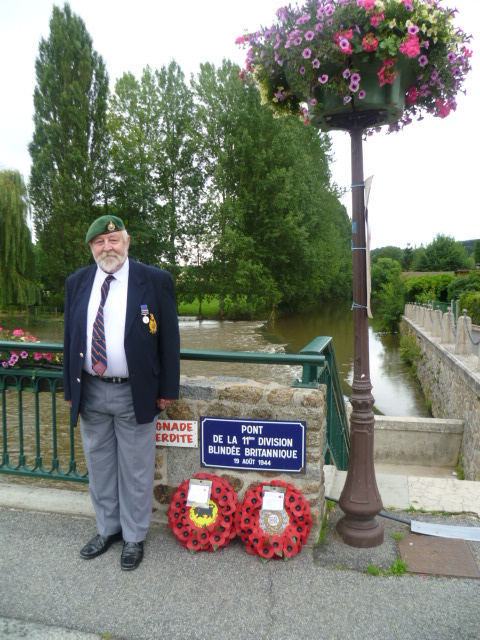
CLIVE MACPHERSON
Some of the most critical material within our upcoming Fairbairn Sykes book was made available by the generous contributions of Clive MacPherson, former Royal Marine and Historian.
In particular, Clive was responsible for unveiling the connection between the early commando troops and the Metford-Fairbairn knives. He also provided us with the link between Fairbairn and Sykes and John Wilkes, Gunmaker.
There are invaluable quotes within the pages of our book attributable to Clive and his anonymous companion “Fred.” Thanks to both of them for their assistance, and their military service to God and Country.
Some of the most critical material within our upcoming Fairbairn Sykes book was made available by the generous contributions of Clive MacPherson, former Royal Marine and Historian.
In particular, Clive was responsible for unveiling the connection between the early commando troops and the Metford-Fairbairn knives. He also provided us with the link between Fairbairn and Sykes and John Wilkes, Gunmaker.
There are invaluable quotes within the pages of our book attributable to Clive and his anonymous companion “Fred.” Thanks to both of them for their assistance, and their military service to God and Country.
Here is a new story. We honor the deceased veteran and his service. I have been given permission to post this photo and thanks to Alex for sending them to me. There are commercial versions of this in a 3rd pattern but they have the badge affixed to the guard which is dumb as it gets in the way of your hand. Here is Alex's story.....
"Hello I acquired this Fairbairn- Sykes 2nd pattern recently. The knife was a special commission to makers William Rodgers in 1970 by then a serving Sargent of 22 Regt SAS based at Stirling lines HQ Hereford. His tours of duty include Oman 1970 - Ireland 1976 ( 3 tours ) - Falklands 1982 - Peterhead prison 1987 - and gulf war 1990 . The person I bought it from contacted William Rodgers and they have confirmed to him that this was a personal one off manufacture at the request of the serving soldier. The name of the soldier has been withheld at the request of his family. Sadly he died in 1992."
"Hello I acquired this Fairbairn- Sykes 2nd pattern recently. The knife was a special commission to makers William Rodgers in 1970 by then a serving Sargent of 22 Regt SAS based at Stirling lines HQ Hereford. His tours of duty include Oman 1970 - Ireland 1976 ( 3 tours ) - Falklands 1982 - Peterhead prison 1987 - and gulf war 1990 . The person I bought it from contacted William Rodgers and they have confirmed to him that this was a personal one off manufacture at the request of the serving soldier. The name of the soldier has been withheld at the request of his family. Sadly he died in 1992."
Harlow F. Dean
Below: There is nothing too special about another thin bladed Third Pattern. But, the story behind it is quite special and it comes from the grandson of an OSS agent named Harlow Dean. According to his grandson: "Harlow F. Dean was a tall, charismatic Concert producer in New York City when the war began. He told me stories of being approached by the OSS recruiters, not knowing what organization they were recruiting for of course, and given a very short period of time (maybe 24 hrs) to decide whether he was going to join them or not." He trained in the mountains surrounding Camp David. One of his more glamorous tasks was shadowing Marlena Dietrich to make sure she was not working as a spy while entertaining the troops. His knife in these photos is not the traditional OSS Stiletto. The sheath is specially crafted and was said to be carried in his briefcase most of the time. If only knives could talk we'd hear some great stories. Our thanks to Kevin Mills for this story and to his grandfather for his service.
NEWS FLASH: I just heard back from Kevin with a terriffic update. He found a photo of his grandfather on assignment with Marlena Diethrich, which he shares with us. What an mazing story! Thanks Kevin. God bless such men as your grandfather.
NEWS FLASH: I just heard back from Kevin with a terriffic update. He found a photo of his grandfather on assignment with Marlena Diethrich, which he shares with us. What an mazing story! Thanks Kevin. God bless such men as your grandfather.
Knife Making Runs In the Parkinson Family:
Peter Parkinson's father was also a knife maker early on. His story could have also fit into the section about converting bayonets into knives. I believe that men have been grinding bayonets and broken swords into fighting knives for centuries. Quality Steel has always been a precious commodity. While the resulting knife is not an X-dagger or a Fairbairn Sykes it obviously took a lot of work to change the bayonet into a knife. The lesson here is that it is very difficult to make steel, but it is possible with a few tools to make a knife from existing steel. Here is Peter's story: "About 1958 he became a scoutmaster in our local area back in Liverpool. An accomplished engineer and fitter he decided to, rather than buy a knife, he made one. He was given a 1907 SMLE bayonet and so fashioned one from it. A bowie style blade with a flattened FS style handle. The fittings are stainless steel, the bolster and guard are silver soldered on the handle side. The handle material is Red fibre and ebony." Illustrated below is a 1907 bayonet for reference.
Captain R.H. Phillips: All's Well That Ends Well
Once in a lifetime we get a chance to undo a bad decision. One of the visitors and contributors to this website sold his father’s WW-II Fairbairn. No sooner was the deal done than he regretted his actions. After a short period of time he contacted the buyer hoping to buy the knife back. Alas it had been traded off at a gunshow. This should have been the end of this story, one that happens all too often.
The contacted party said they would keep watch to see if the knife surfaced again and they would try to buy it back. No doubt, like me, you are calculating the odds of that happening. Months passed (turns out it was about 2 years) and the son had nearly given up hope of ever recovering the knife. As a last ditch effort he emailed the buyer one more time. The original buyer responded that he had the knife but he had lost the son’s contact information and had no way to contact him. Long story, short, perseverance paid off and the knife was recovered. (On a personal note, I have seldom fretted over a knife bought, but often regretted one sold.)
This is a wonderful ending to what could have been a lifetime of regret. The painful lesson learned by the son of the veteran has been impressed upon his daughter, who will inherit the knife next. I am willing to bet it will be many generations before this story is forgotten. I want to acknowledge the generosity and largess of the man who went out of his way to retrieve a knife that had no personal meaning to him, although he said he regretted parting with it, both times. Those men have become friends, and their daughters will inherit their collections. I hope that others will read this story and think twice before selling off your inheritance for a few bucks. These are special things, we are only temporary keepers of them, and it is our duty to pass them on to our heirs.
The contacted party said they would keep watch to see if the knife surfaced again and they would try to buy it back. No doubt, like me, you are calculating the odds of that happening. Months passed (turns out it was about 2 years) and the son had nearly given up hope of ever recovering the knife. As a last ditch effort he emailed the buyer one more time. The original buyer responded that he had the knife but he had lost the son’s contact information and had no way to contact him. Long story, short, perseverance paid off and the knife was recovered. (On a personal note, I have seldom fretted over a knife bought, but often regretted one sold.)
This is a wonderful ending to what could have been a lifetime of regret. The painful lesson learned by the son of the veteran has been impressed upon his daughter, who will inherit the knife next. I am willing to bet it will be many generations before this story is forgotten. I want to acknowledge the generosity and largess of the man who went out of his way to retrieve a knife that had no personal meaning to him, although he said he regretted parting with it, both times. Those men have become friends, and their daughters will inherit their collections. I hope that others will read this story and think twice before selling off your inheritance for a few bucks. These are special things, we are only temporary keepers of them, and it is our duty to pass them on to our heirs.
The Son's Story:
"This is my dad, Captain R.H. Phillips, at age 23, in 1945. He enlisted on 1/2/42, served in the Panama Canal Zone, went to OCS at Ft. Benning, GA March - July, 1943, then got orders for overseas duty. He spoke German so, of course, they sent him to China. While in Bombay, India preparing to fly "over the hump" into China he met a British soldier who was on his way home. The British soldier gave Dad the knife saying "You'll need it more than I will where you're going." Soon after Dad flew into Kunming, China and began his two years there. While in China he fashioned the bamboo reinforcement for the sheath for a faster draw. He was in China from October, 1943 until September, 1945, serving with Y Force for part of that time. He fought with Chinese troops in hit and run tactics behind Japanese lines and there were bounty posters for his capture. He also fought in the Salween River campaign for which he earned the Bronze Star." Quoted verbatim
Below: Here is the knife which was given to Captain Phillips by that returning British soldier as Phillips prepared to board an aircraft for transport over the Hump. The image clearly show the ingenious modifications using bamboo tied to the sheath to strengthen and stiffen it. This is an interesting knife that is completely unmarked. It also has the thinner blade with small triangular grinds at the guard. Most often I have found these knives stamped on the guard with a "56". The captain and his heirs have nicely preserved the knife in mint condition. An exciting story we are pleased to share with you.
A.H Pechell: His Story:
Seldom do we find out the story behind any knife, even the so-called "Named Knives." Searches on Commando Veteran pages do not even provide the results one would hope for. So when we were lucky enough to be contacted by a son of a WW-II veteran, with his story, we were very grateful for that son (and daughter) sharing these photos and a bit of his story with us. It was through the sacrifices of such gallant men that freedom was preserved.
|
Below: A.H Pechell, with and without mustache, he is a dapper young officer and gentleman who served his country honorably. God rest his soul.
Dear Sirs,
AH PECHELL I was fascinated to see my father's name on the sheath. He was in the RASC (Royal Army Service Corps) and served under Alexander. He saw action in N Africa, Italy and was at Monte Casino. He also failed to be evacuated from France and was listed as missing in action but escaped on a motorcycle to Brest where he managed to get a boat back to England. Sadly he died a few years ago, but I am in possession of some of his army memorabilia, medals, badges, a bugle, and a trophy for a motorcycle trial. During the war he achieved the rank of major at the age of 27 and retired as a Colonel. Yours John Pechell Our sincere thanks to John Pechell and his sister for sharing. |
Below: A.H Pechell, back row fourth from left
|
Below: This is the Inverailort dagger, a First Pattern knife made by Wilkinson Sword Co. London, that belonged to Col. A. H. Pechell.
Fabrice Beaudot's Story:
A Most Unusual Knife:
Here I have included a very unique knife and interesting story from a friend in France. I have taken some liberties in editing his story. Hopefully I have made appropriate changes. Thank you Fabrice for permitting the use of your photos and materials. Another example of a period knife from a bayonet.
"This part of my collection did not always reveal its secret. It was found during the second world war on a dead German in the Loire. The materials also included radios (which unfortunately have not been preserved). My research and expert opinion confirms that many WW2 resistance forces, English commando and Jeremy (and others) including Jedburgh jumped into this area. It is true that they jumped into lands held by Germany. (The piece had
been dropped, or given, or taken by a real German). It seems to be made from a reshaped English bayonet blade. A rod was screwed into the blade,
which is well studied since that weak point is reinforced by a pin assembly directly between the blade. The handle extends through (into) the thickness of the guard (therefore no rotation can occur) It has 2 punch marks on the guard of marine anchors, which I cannot explain." Fabrice Beaudot
Here I have included a very unique knife and interesting story from a friend in France. I have taken some liberties in editing his story. Hopefully I have made appropriate changes. Thank you Fabrice for permitting the use of your photos and materials. Another example of a period knife from a bayonet.
"This part of my collection did not always reveal its secret. It was found during the second world war on a dead German in the Loire. The materials also included radios (which unfortunately have not been preserved). My research and expert opinion confirms that many WW2 resistance forces, English commando and Jeremy (and others) including Jedburgh jumped into this area. It is true that they jumped into lands held by Germany. (The piece had
been dropped, or given, or taken by a real German). It seems to be made from a reshaped English bayonet blade. A rod was screwed into the blade,
which is well studied since that weak point is reinforced by a pin assembly directly between the blade. The handle extends through (into) the thickness of the guard (therefore no rotation can occur) It has 2 punch marks on the guard of marine anchors, which I cannot explain." Fabrice Beaudot
Below: Here are two historical links to the Fairbairn commando knife story. On the left, our first X-dagger which is made from a bayonet. On the right is an original Shanghai dagger also made from the same style of bayonets. There is much more to this story on the page dedicated to X-daggers.
My Note: The first pattern is a lovely fighting knife, but as explained further down, the "S" guard forces the knife to be held most comfortably in one direction only, making it harder to roll the knife from one hand to the other as WEF trained and taught. There are rare original first pattern knives with a straight guard. The rounded handle (as opposed to flattened oval) aalso makes it more difficult for the user to determine the exact orientation of the blade angle in his hand. One sentry removal technique called for thrusting the blade into the enemies neck while holding his head back. Then, by pushing the blade forward you nearly decapitate him. Obviously this will not work if in the dark or heat of combat the knife is thrust in with the blade in a vertical orientation. I agree somewhat with the issues of the "S" guard, but not so much with the second concern of the round handle. A lot of this has to do with personal tastes and skill level. Personally, when I train or teach knife fighting I do not recommend tossing the knife from one hand to the other. There are tactile ways to know the orientation of the knife in your hand without having flats on the handle. There are examples though, of original knives whose owners ground or filed flats on the handles or in the guards just for that purpose, and to prevent the knife rolling in their hand.
|
A UK Visitor's Dagger:
"I can confirm its original owner. Who was a polish defector during ww11. originally being a camp guard he defected and made his way to the UK where he was enlisted in the polish commando forces and sent back into theatre. sadly he is now dead as are many. I inherited the knife from his grand daughter." It is this willingness of viewers to share that will make our website grow and become a more vital reference. Thanks Mick. |
Documented Polish FS:
This knife photo and story has been provided courtesy of the CMSM Museum. It is an extraordinary example of the rare smooth handled dagger. "It belonged to Private Ignacy Girzda of the 1st Polish Parachute Brigade. He was General Sozsobowki’s bodyguard. We have this listed as a “Polish” FS knife with unusual aluminium handle. We have the provenance for this knife along with the man's medals, including the Polish Arnhem medal and a clasp knife given to him as a gift by Sosabowski." Thanks Clive for sharing this valuable knife and story with us. |
One of a Kind: This knife was obviously personalized by one of its owners. The question is who owned it last, a German or an Allied Trooper? The handle of the heavy bladed knife was replaced with a bakelite one from perhaps a kitchen knife. The pommel end has a Swastika cut deeply into it. We will never know the history behind this modification. The guard end of the handle also has a spacer of plexiglass. The guard is the original and the sheath is nearly standard F~S with the exception of a slight modification to the frog. Some men disliked the cold feel of the metallic handles. Others disliked the round shape because the knife could roll in your hand, misaligning the edge of the blade. So you will find field modifications like this from time to time. Another example is the Del Buono second pattern with a Lucite handle under the Second Pattern, Named Knives, page.
Bent But Not Broken:
This P-2 Fairbairn Sykes has a story to tell but we will never know what it is. It was excavated on the beach at Dieppe some 30 years ago. The Dieppe Raid took place 19 August 1942. Over 3,000 of the 6,000 some Allied troops involved were either wounded, killed, or captured. The blade is badly twisted, bent, and rust pitted but it is about 95 percent intact. The handle is also bent and some idiot tried to remove the top nut, grinding much of it away. Despite all of this abuse the knife is solid and fairly tight. I bought this proud knife from a dealer in England, deciding it deserved a good home.
This P-2 Fairbairn Sykes has a story to tell but we will never know what it is. It was excavated on the beach at Dieppe some 30 years ago. The Dieppe Raid took place 19 August 1942. Over 3,000 of the 6,000 some Allied troops involved were either wounded, killed, or captured. The blade is badly twisted, bent, and rust pitted but it is about 95 percent intact. The handle is also bent and some idiot tried to remove the top nut, grinding much of it away. Despite all of this abuse the knife is solid and fairly tight. I bought this proud knife from a dealer in England, deciding it deserved a good home.
|
The handle is stamped with the government broad-arrow and the number four. The corrosive effects of being buried for 40+ years on a beach are evident. The long tapered bevels on the blade where it enters through the guard are perhaps indicative of manufacture by J. Clarke & Sons, Sheffield, England. Note the bend in the handle.
|
